My next LDD in Wonderland doll is actually the choice that would have made sense to start the look at the collection--Alice, played by one Living Dead Dolls Sadie.
In the timeline of Sadie dolls, Alice comes after:
- Series 1
- Series 2 (Schooltime)
- Series 7 (Bedtime/Sloth)
- the Minis versions of those dolls (links for reviews of Minis Bedtime Sadie--which preceded Sloth--, Series 2, and Series 1)
- Fashion Victims
- The pencil sharpener
- Resurrection
Please read my first LDD in Wonderland review for the proper prelude and context regarding this series.
I got Alice through the deal that got me Maggot, S1 Sin incomplete (since sold to a better home), and Vanity. Alice came complete in her box, though there's less to worry about with the Wonderland dolls and the boxes aren't necessary to me because they're not coffins and they have no certificates. I'd have accepted her loose, so long as she wasn't missing a shoe or her headband.
This is the first doll from "Living Dead Dolls in Wonderland" or "The Lost in Oz" I'm getting where I owned the "actor" character's original doll first. I got Purdy (Scarecrow), Dr. Dedwin (Wizard), the Bride of Valentine (Tin Man), Walpurgis (Wicked Witch), and Inferno (Queen of Hearts) through these two doll lines without owning their original designs fully as themselves. Here, though, I got the original Sadie first.
The velcro circle next to the window had come unglued on this box too, but it was still stuck to the loop half of the velcro pair, so I pulled it off and glued it back where it was supposed to go.
Sadie Alice features classic hallmarks of the Carroll character--a pinafore dress and a headband, but not striped socks (though her variant has them!) The headband and striped socks were added in John Tenniel's original illustrations from Through the Looking-Glass, but were not part of Tenniel's art in the first book. Alice here features red as her main color rather than the blue typically used for Alice. There is precedent for this, though. The 1985 TV movie adaptation of Wonderland and Looking-Glass, which I watched as a kid, dressed its Alice in red.
 |
| Natalie Gregory as Alice. |
This adaptation is fairly standout for adapting both Caroll books fairly comprehensively and by the book, though it's full of low-budget camp, several celebrities who seem to have been bigger in the previous decade, and some Americanized and 1980s period tonal choices, as well as stringing the two books together with an immediate segue and making the Jabberwock a real monster for Alice to be threatened by during Looking-Glass. I think it also completely misses the point of the books, despite its faithful adaptation, because it reframes Alice's two journeys as a path to be seen as grown-up and join the adults' table at a tea party, all when the books seem fairly clear on the message that adults are unfair to children and that kids should enjoy their childhoods and have freedom to be kids while they can. Alice isn't about the goal to grow up and leave childhood behind at all. In that sense, I find Jim Henson's Labyrinth to be a more spiritually faithful adaptation of Alice despite not being an Alice story at all, since Labyrinth has a similarly surreal and witty episodic fantasy setting and closes on the idea that you don't need to grow up too much or lose your sense of childhood whimsy.
Sadie herself is typically associated with black and white clothing per her obvious derivation from Wednesday Addams, but she has worn red on occasion, such as in variant LDD Minis and in accents for her Resurrection variant, but red is typically associated with Sadie's costume lookalike Sin instead, so I'm a little surprised Alice isn't dressed in all black and white. Her variant has a black dress but doesn't eliminate the red, and on this Sadie, red even makes it into her eyes. While red usually isn't Sadie's territory and this is the most she's ever been associated with the color in any of her designs, I can't say she doesn't rock it as Alice.
But she's not rocking it out of the box. She is, as I feared, a 2010 Living Dead doll with all that implies. Her hair is a mess, her headband is useless, and her costume has tons of loose threads.
The doll's hair is rooted with a style typical for neither Sadie nor Alice, as it's waist-length with bangs across the forehead. Alice in the books has hair pulled back out of her face with no bangs, while Sadie most often has a center part with no bangs, though she did have them previously as Minis Bedtime Sadie (but not the full-size Bedtime edition released after as Series 7's Sloth) and Resurrection-main Sadie, and got the bangs again afterward for her Return debut. The hair looks thinly rooted and is all out of order, far from the tidy look it needs.
The bangs are gelled a little and I worry about their prospects for lying flat because they're just a single row of rooting.
The headband is a joke, which I should have expected after seeing Alice's contemporaries Rose and Violet. It's a red satin loop with some gathering and elastic at the back to give it stretch, but LDD has again tried securing a headband loop on the back of the head where there is absolutely nothing giving it tension. A doll's chin can stick out and catch a band against the top of the head, but there's no "shelf" at all on the back of the LDD head sculpt which the headband can brace against and stay tight with securely. It always wants to slip backward and fall down off the hair. This should have been a plastic piece shaped as an arc that hugged the top of her head like a real headband would, because this is frankly delusional. How did Mezco think this piece would work? I was able to replace Rose and Violet's useless ribbon headbands with wire arcs that held their hair bows on and slipped over the top of the head, but that's not an option for this style of piece.
We can start getting positive with the face.
I like the doll's faceup, primarily for being one of the Sadies with the high-contrast mismatched eyes I prefer for the character, and with a new take on them. Several Sadies have either matching pale eyes or subtler mismatched eyes, but I like when the two eyes have cartoon-goth contrast, and that's the case here. Matching her Series 1 original doll, her right iris is black and her left iris is white, but her pupils are red on both sides here instead of being the opposite color to the iris, giving the eyes a different look. The eyes themselves are also narrowed with an almond outline that changes the expression a lot. Sadie's eyebrows are harsh but with a thicker, more elegant curve than S1, and she has larger, fewer lashes just on top and black airbrushing around the eye that works really well for her. It makes her pale skintone look greyer and deader and her expression looks a lot heavier. Her lips are black and shaped with the paint in a delicate vintage-dolly style, and she has a playing-card spade marking under her eye. While playing-card motifs are often put on Alice, I could honestly do without it because the card characters are separate from Alice herself and putting that motif on her feels insecure, like we won't recognize the character or her context without mixing in other characters' iconography. It doesn't help that the black paint is a bit reflective and catches the light so the spade ends up greyed out when light hits it. However, I do understand why she has it--the card suit of spades is typically associated with death. It's black and can be read as a spearpoint, and the Ace of Spades card in particular is a very common symbol of death. While Spades, Clubs, and Diamonds cards have no narrative relevance to the original Alice story, Alice being marked with the suit of Spades makes sense.
There was some really gross...whatever on the sides of Sadie's face.
This girl needs help.
The dress is mostly cotton, depicting a take on the classic Alice pinafore. While Alice's dress is mostly blue in pop culture, it's been illustrated yellow by original artist John Tenniel, and different interpretations change the color, such as the 1985 two-parter discussed above. Red is a fun choice for the costume, feeling bright but also edgy, and it doesn't step on the toes of American McGee's Alice, which used a raven-haired version of the character who wears dark blue.
This copy's dress is messy with the loose threads.
The dress has a rounded shirt collar, puffed sleeves with elastic gathering at the bottom but no defined cuff, and a high waist and wide skirt trimmed by white lace. The collar will lie flat, but really wants to pop up. Over the top is an apron section which covers most of the torso save for a small gap below the collar, and has a black waist ribbon tying it in back in a bow. Two thin black stripes trim the apron above the lower edge.
At her neck, she has a sewn-on small accent of a brooch with ribbon below. The brooch is printed felt with a skull symbol, and is rotated. It can be turned on its sewn point, but rested askew. The print isn't centered on the felt disc.
Here's the back of the dress with the apron tie.
While the apron needs untying to take the dress off, it is not a separate piece--it's sewn down to the top of the shoulders and does not cross over or connect in the back of the neck.
Under the dress, Alice has plain black footie tights. Under the tights, her underwear is painted glossy red. She has black Mary Jane shoes.
Fixing Alice was an ambitious project. I combed and boiled her hair, but I just wasn't sure about that headband. Finally, I decided to use the piece she was given, but use pins in the head to keep it on. I poked two in just under the back of her hairline to put the band around so there was something bracing it in tension on the back of the head.
With the band hooked around these pins, I was able to push it up to the front of her head the way I wanted it, whereupon I put in another pin to catch it and stop it from slipping backward. Then, I was able to push the pins all the way down so the edges of the pin heads pressed down the ribbon of the headband.
It's not visually perfect, and the doll's hair pattern is thin, but this keeps the headband on so I basically never have to fuss with it again--and that's more than enough for me.
I also tidied up some of the loose threads of the outfit and was able to turn and tack down the brooch so it faced upright. Here's Alice looking presentable after all that.
Here's Alice next to Series 1 Sadie.
Alice's variant doll is very striking, switching to stark white skin and a black dress, with blood splatter on the pinafore. She adds the stripes of Tenniel's Looking-Glass artwork on her tights. The spade marking on her cheek has changed to red, which is just...incorrect. Why not change things to a red card suit instead so she had a heart or diamond?
She's still pretty, and it's still possible I'd get her someday, but the red spade genuinely throws me off.
Of course, this wasn't everything. Because LDD had to design my personal Kryptonite. In one of their most brilliant and cruel moves, they released an extra set depicting this same LDD Alice character design in two other sizes, including a unique oversize doll type to depict her shrinking and growing, pairing with the standard mass-release doll for all the size-shifting shenanigans you could ever hope for...and they made it a convention exclusive.
I've made it clear on multiple occasions that one of my favorite things about toy figures and dolls of Alice is that they're technically always "life-size" and so they're delightful to stage in different scale environments, and now here's a toy company actually making the doll in multiple sizes for just that purpose. This made it a deeply covetable release. My plan was always to get it someday, but I still knew it was very expensive and my grand plan was to offset the cost with some gift-card money I'd come across. I ultimately found eBay forcing me to pay in full because I couldn't divide the cost between the gift card and normal. Gift money went elsewhere to other productive things but I'd really have liked to use it for this, just on principle. So it goes. I got the Alice set with the LDD in Wonderland printed storybook, so I can discuss that too.
The box is a unique design with no windows or front panel flap. It opens at the top with a flap and a removable tray. The box is printed on the sides with a wrap-around image showing little Alice at the foot of the table in the hall of doors where she discovers the "DRINK ME" elixir and "EAT ME" cake. The door we see is the small one Alice tries to get through in the book. Big Alice is seen from the hem of her dress downward, and the phrase naming the collector set is printed on the thin sides. The mini Alice on the box has painted nails, but none of the produced LDD Alice dolls do. The big and small dolls are based on the main edition, so variant Alice is not compatible with the gimmick of this set. There was no alternate release of this set with colors matching the variant Alice. The two dolls in the box art are not depicted to scale. While there's a dramatic difference in the actual toys inside, that has been increased for the artwork, where big Alice is proportionally even larger than little Alice.
The box feels big, but isn't that much taller than a regular LDD in Wonderland box, which sets a clearer expectation of how big big Alice will really be--not super dramatically huge beside the standard.
Here's the tray of dolls removed. The cardboard insert has no special detail; just black gloss print behind the plastic tray. My set of dolls was wired in and never removed from the tray, which is ideal for getting their hair sorted and hairbands secured because their hair should be pretty much tidy from the start.
While the set is titled "A Drink to Shrink...and a Cake to Grow", only a drink is actually featured as a prop/accessory. It's a small green plastic translucent sculpt in the form of a Victorian medicine bottle, per the book, and the words "DRINK ME" are painted purple on the side with low contrast and poor legibility--not even a label painted on the bottle to backdrop the text. Carroll's text specified the words were on a label tied around the neck in the book, which I would have preferred to see. The bottle has no way to be secured to the dolls' hands on its own. You'd need to employ a dab of putty.
Here's how it scales with standard Alice in-hand. I think Mezco could have made the bottle a little larger and that could have given them an easier surface to decorate so it would look better.
When she takes a drink, though, it becomes about a fifth of her height!
Shrunken Alice is depicted through a Living Dead Dolls Mini, marking the first time a Mini was designed to share space with the larger standard dolls. Previously, Minis all occupied their own separate doll scale and were fully a spinoff line, but Alice inherently breaks the concept of scaling and made a Mini into a scale doll! Being a Mini changes her proportions and sculpting from the standard, and from the look of both other Alices, but it was an easy way for them to have depicted Alice at smaller scale given that they had all of the molds for a small character. While the Minis series ended at Series 6, which was based on the 2008 release of Series 16, the Xmas Carol Minis set came out in 2009, while LDD in Wonderland came out in 2010. That means the Minis weren't exactly being dug back up from the grave to produce little Alice. The Minis series' cancellation wasn't long enough before LDD in Wonderland that their re-emergence here would have been so surprising. Minis would also be produced, also designed to be in-scale with normal dolls, in the Oz line to depict the diminutive characters of the Munchkins and the Flying Monkeys. It looks like there was a Minis dormant period between Mini Alice and the Oz Minis (2010 to 2016), so their use there was more surprising.
Mini Alice is wearing a hairband that works just like the main doll's, but her hair has more proportional volume keeping it place. It is still too easy for it to slip forward, so I ultimately decided to push a pin through the top of the headband into the head to keep it in place later on. I know it's heresy for such a rare item, but I want to be able to enjoy it, and it wasn't working at this scale to pin the edge of the band under the lip of the pin head. It wasn't holding that way and it had to pierce the band.
The hair is pretty tidy as it starts, though its rooting isn't more even than the regular Alice. The bangs lay okay for their size.
The faceup is as 1:1 to medium Alice as most LDD Minis adaptations are to their source dolls'. The biggest difference is how the lip sculpt changes the shape of the mouth and doesn't give her the same pouty dolly-lip effect.
The dress is pretty faithful, just with some distorted proportions at this smaller scale. The felt brooch medallion at the neck has been replaced with a button, and the pinafore is not sewn as a separate overlay on the torso and has no dip at the neck. The back of the dress also has no ribbon tie (genuinely, thank you, Mezco; that would have been very fiddly) and the piece velcros all the way down the back to open like a doll shirt--it doesn't have to slide down her legs.
 |
| There were some loose threads to cut and poke into hiding, and the stripe print on the dress is incomplete, with a patch missing some ink.F |
I was very surprised to see Mini Alice has actual cloth tights of the same fabric as the standard doll. Minis' tights and socks are usually just painted onto the legs.
 |
| The perks of being a rare exclusive. |
Mini Alice's legs are molded a little spread apart so her feet aren't flat, but she stands okay when her shoes are on.
Now imagine her eating a cake.
Giant Alice is built on a unique 13-inch LDD body that hasn't been seen before or since. In all respects, there's a smaller gulf between medium Alice and giant Alice than there was between Mini Alice and medium Alice. The big doll isn't as proportionally larger (the lineup goes 4in-> add 6 to get 10 in-> add 3 to get 13 in, while an even incremental scale would be 4in-> add 6 to get 10in-> add 6 to get 16in). The body sculpt design/proportions are pretty close to the medium doll, just molded bigger, so there's less stylistic difference too. The big doll is still a unique LDD body size with one-off doll molds, however, making her an object of curiosity and curiouser-osity.
Similar hairband and hair situation here, though big Alice's bangs are longer proportionally than the other two renditions'.
To secure this Alice's hairband, I put a pin through the back/bottom of the band at the back of the neck where it wouldn't show. It sat well enough on top that I didn't pin it down there. Medium Alice called for the most pins, but also needed the least invasive pinning, only piercing her head instead of the band. Listen. Mezco didn't design this doll well. We're both guilty for my alterations.
Giant Alice has inset eyes just like a Resurrection LDD, and alongside Eggzorcist's 10th anniversary dolls, the redesigned Scary Tales Beauty and the Beast, and the Series 35 mystery dolls, is in the club of classic LDDs with inset eyes who were not part of the Resurrection doll line. The wave 2 Fashion Victims have a different art style and different inset eye styles, so I don't count them in the same group. The eyes look pretty big, have proportionally larger pupils, and also remove the lowered-lid effect of the face, giving this version of Alice an eerie staring quality.
I feel like the ears on this head mold might poke out to the sides just a tad more?
Here's the Resurrection face to compare.
Here's the three Alice faces together. It's kind of fun that there's something different about each face, rather than two dolls looking identical at different sizes while the third doesn't. It's only fair for each version to be stylized a bit differently since they chose to use a Mini doll which is inherently different in look.
The big doll is quite pretty and feels made for portraits.
 |
| I splattered this white rose paper with red paint as if to turn them red with blood. |
Big Alice's outfit is quite similar to the medium size. The collar feels bigger and turns down more on the big dress rather than lying flat on the top, and the brooch uses the exact same felt medallion as the medium size, just with longer ribbon tails. As such, the brooch is smaller on the larger costume.
The back of the dress has a ribbon tie for the pinafore, but the pinafore isn't a separate piece here, either, and is sewn to the shoulders in the same way as the medium dress.
The lace hem on all three dresses is different, though big and medium are more similar.
 |
| Left-medium, center-big, right-small. |
Big Alice is wearing tights, and...the wrong shoes.
I'm not sure why, but the shoes for big Alice are a slightly upscaled version of the typical LDD boy's shoe mold, rather than the Mary Janes the other Alices are wearing.
Was this an artistic choice? A practical one? A total error that was too late to correct? Was there going to be at least one more doll built at this scale who would use this shoe type, but it never happened? Very odd. It certainly doesn't harm the doll, but it's a strange inconsistency. The giant shoes are a firmer vinyl than the medium shoes and fit Alice tightly as well as making her stand very stably.
The big Alice body is just an upscaled version of the standard ball-joint LDD frame. It's still all vinyl on the big doll, and its joints move the same--and quite smoothly. She's quite pleasantly hefty and chunky as a big doll. Big Alice does not have painted underwear.
Here's all three bodies together, but the Minis body is sculpted and built quite differently, with swivel joints for the head and hips and rotating hinges for the shoulders. Only medium Alice has underwear paint, but none of them really called for it because all three are in tights.
This is possibly the first time a doll line used an oversize doll as a canonical "giant" to scale with the normal output of the brand. Later on, Mattel would get on board in Monster High with Gooliope Jellington, an oversize doll who's not a giant version of anything (she's just a giant monster all the time, not a temporarily grown state for a normal-size character). Gooliope is 17 inches to Monster High dolls' typical 11.
Gooliope would be joined by a few oversize remakes of standard-size Monster High dolls, recreating signature Frankie Stein, Draculaura, Clawdeen Wolf, and Elissabat, none of which were intended to share space with the standard line the way Gooliope was. All of these "Frightfully Tall" dolls featured increased articulation that Made to Move Barbie dolls would shortly thereafter imitate (and slightly exceed) at the normal 1/6 scale. 11-inch Monster High dolls have never gotten the Made to Move treatment and I din't think you can comprehend how feral I'd go for a MtM MH schema if it were ever to be released. Ever After High would also do a similar application of size-shifted dolls specifically for an Alice in Wonderland gag with its 17-inch rendition of signature Madeline Hatter. Giant Maddie was the brand's only doll in this scale. Maddie got this honor for being the Wonderland story's most prominent representative in the EAH cast...and let's be honest, there's no market for oversize boy dolls, so Alistair Wonderland didn't get an edition like this despite the brand's analogue/descendant for Alice herself making more conceptual sense for the size gimmick.
Monster High G2 also featured another, slightly less giant, character rendered as an oversize doll--Treesa Thornwillow, who depicts a dryad the size of a tree and grows from 13.5 inches to 14.5 inches. The jump between a regular Monster High doll and Treesa is closer to the jump between standard Sadie-Alice and giant Sadie-Alice. Regular MH to Frightfully Tall is a wider gap...and honestly, the kind of size relativity I'd have preferred between regular and giant Alice.
 |
| Treesa and Gooliope are both modified and restyled. This and the following picture show Treesa at compressed height. |
Mini Alice completes my collection of Minis Sadies who have larger counterparts. There's a red-pajama variant Mini Bedtime Sadie with no full-size counterpart, and a Minis-only Sadie design with variants, none of which match to a larger doll, but this is all the Minis Sadies who do have a larger counterpart. Of these, only Bedtime Sadie was not an adaptation of a larger doll, because her larger matching counterpart was made after the Mini debuted the design.
The last thing to review is the LDD in Wonderland printed picture book! This was available through Mezco direct, as advertised on cards in the dolls' boxes:
 |
| Disclaimer in the corner: Image shown is not of actual book. |
Darn right the image shown wasn't the actual book, because the real thing is a slim landscape-orientation hardcover with a glossy dust jacket.
The hard cover under the jacket is also glossy and printed the exact same way.
There is no print on the inner flaps of the dust jacket. That's fine. This was never available in bookstores.
The book is credited to Mezco's Mez Markowitz and illustrator Mike "Gorilla" Pasquale. There's also a harsh reminder not to reproduce the book, which is fair. Much as I'd like to distribute this obscure content to the masses, I'm not within my rights to do so, so I can only share snippets of artwork and won't share any full illustrations or spreads.
The visual of the illustrations is a really cool semi-photographic style, where I'm not quite sure how the images were produced. The dolls look pretty darn real, save for obvious changes to animate their facial expressions or shape/tidy their hair, and the dolls and scenery look unified rather than collaged. I wonder where photo ended and editing/purely drawn or painted imagery started.
The book displays a few morbid parody twists on Alice that the dolls don't quite convey. For one, the Queen of Hearts is given an axe like I thought she should be, being illustrated holding the LDD axe mold that debuted with Lizzie Borden. I made her a more character-specific axe when I got her.
 |
| The existing LDD gripping hand sculpt couldn't actually hold the existing axe, though--the axe handle is far too thick and uses a peg/palm connection in reality. |
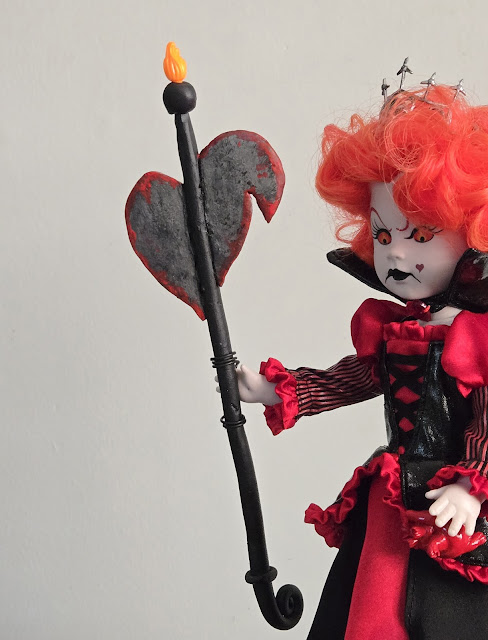 |
| My custom Wonderland flaming heart axe. The handle here is a wire-wrapped finger loop. |
The story also shows morbid twists by depicting Alice playing in the graveyard before falling down an open grave into Wonderland while chasing the White Rabbit. The Queen's croquet game is played with human skulls as the balls (making it less cruel to animals!), and the white roses stained red are clearly sprayed with blood on the cover--an idea I also independently came up with.
The book is told in verse and is an abridged run-through of plot elements from Alice's Adventures in Wonderland. Despite the book alluding to the hall of doors and the growing and shrinking, the big and little Alice dolls make no appearances in the book and only standard Alice is depicted.
In the book, the Wonderland characters who didn't make the doll line aren't depicted as full Living Dead Dolls we just never got, so there's no sense that LDD was sitting on doll designs we were denied. The Caterpillar and March Hare are both realistic designs of a bug and an anthropomorphic rabbit. Of the non-toyline cast, only the card soldiers are given doll faces, but they look like broken disembodied hollow faces and are designed like background characters rather than dolls that would be fully produced as toys--and they're not based on any LDD cast members.
What really threw me for a loop was seeing the illustration of the Hatter's party, because wait a minute, those are the Series 23 skull tea settings, 100% and absolutely!
This book was definitely before Series 23 (two years preceding) and the illustrated pieces aren't fully on-model to the toy props in the sense that the physical pieces would have been part of the photo aspect of this art, so I think what must have happened was that Mike Pasquale designed some awesome morbid tableware for the Hatter as a throwaway and then Mez, Ed, and Damien thought something like "...huh. Well, we probably should have done that. Let's make them real for a tea party series." Otherwise, maybe they were workshopping Series 23 already and directed Pasquale to use these designs in the art despite not producing them as pieces yet? I can't imagine why they wouldn't have made them as accessories for the Hatter if they already had the designs, though, so it might just be the case that the picture book and Pasquale's artwork were the inception of the Series 23 teaware...or perhaps the whole series concept! I might need to see about getting a pale flesh gripping hand for the Hatter to use if I want to pair the S23 tea pieces with her.
One illustration depicts the Queen of Hearts with a screaming face, which I'm honestly surprised the doll didn't have. It would fit her character and avoid the issue of her mouth paint contradicting the head sculpt.
The book ends with Alice waking up next to Lewis Carroll's grave, which is a nice touch.
The last page does the whole "The end?" teaser thing with chess imagery, as if to suggest a forthcoming "Living Dead Dolls Through the Looking Glass" series, but no such thing ever happened (and there was plenty of time for it to have).
 |
| The chess pieces here are kings, but queens would be more relevant to the book. |
I'll go into my own ideas for what "LDD Through the Looking-Glass" could have been in another post discussing what more could have been done with LDD x Alice.
Here are the dolls all tidied and assembled.
The first photos after I tidied the dolls were with big Alice. I set her up in a cardboard dollhouse room (from the Sam and Julia dollhouse brand) to recreate the illustration of Alice when she grows to fill a room in the White Rabbit's cottage.
Because the big Alice doll just isn't quite big enough, I used some small dollhouse furniture from the work I've done with Sadie's dollhouse to dress the scene. The tea menu fell over and I didn't pick it up, but it doesn't kill the pictures.
This was the most authentic to the book's illustration, but I also tried her out in the bedroom of the dollhouse I've been making for Minis Sadie.
Then, I had to stage the scene these dolls as a trio are all directly based upon--the hall of doors. The LDD book illustrations gave me a visual guide on which to pattern my rendition of the space.
The sequence of the hall-of-doors puzzle Alice encounters in the book is thus:
- Alice enters the hall with many doors her size, and a table, specified by the book as three-legged and entirely glass--the latter aspect is more significant and that's the part I focused on. There is a small key on the table, but it is too small for the doors.
- Alice then finds a miniature door behind a curtain which the key would suit.
- She opens the door to find a small beautiful garden behind it--indicated to be the Queen's croquet ground which she only reaches at the end of the story.
- Alice discovers a bottle saying "DRINK ME" on the table which she didn't see before and which may not have been there at all. (I decided it wasn't.)
- The drink shrinks Alice to a height able to enter the door, but now she needs the key again. In the book, it's never explicitly stated that Alice had locked and closed the door after opening it and put the key back on the table--just that she discovered she needed and didn't have the key when she reached the right size for the door.
- Regardless of how it got back up there, Alice sees the key mocking her through the underside of the glass table, on top of its surface. In the book, she tries climbing up one of the three legs around the edge of the tabletop, but finds the glass too slippery. With a single-column design like I made, though, climbing up is outright not an option.
- Alice discovers a small cake under the table in a glass box, with the cake saying "EAT ME" spelled out in currant berries. (I just used Playmobil cake pieces with no container and put the message on a card next to the cake, like in the LDD picture book.)
- This cake grows her far bigger than the door.
- She unlocks it anyway, but can't do anything to go through. She begins sobbing until the White Rabbit appears and drops a fan and kid gloves in the hall after Alice startles him. Alice finds that fanning herself shrinks her back down, now even smaller than before, but she again finds that once she is small enough to enter the door, the key is again back on the table. This is a clearer indication that the puzzle is "resetting" somehow and that Alice has not been absently putting the key back before changing her size. It seems that perhaps she cannot execute the shrink-and-unlock sequence to pass through the door without keeping her eyes carefully on the key at all times. The tears she shed while giant have turned into a flood that sweeps her away now that she has shrunk, and Alice never completes the sequence to go through the little door. She should have either pre-opened the door before drinking the shrinking elixir, watching the door all the time until she was the right size to go through, or put the key by the door and shrunk a small amount to open the door once she was the right size. This is all fairly irrelevant, though, trying to logic out a deliberately illogical dream scenario.
The hall itself was composed of three poster boards. I dabbed red paint on to mimic the LDD book artwork and used duct tape strips for the baseboards, and cut holes in for doors--the 1/6 model I have, the 1/12 model I had, and then a 1/24 model I had to get for the tiny door, of the same design as the 1/12 model.
The little door had to end up as a squeeze for little Sadie to fit through, but she'd manage to fit through it. There just aren't dollhouse doors made at 5-inch or 6-inch scale that would suit a LDD Mini perfectly, so I went with the best available.
I needed an actual opening doll door with the right visual style if I was going to place a "rose garden" behind it. The other two doors could have been nonfunctional for my needs, but the little door needed to open!
The walls of the room were stuck together with nails, but I employed a couple of screws to counteract the bend of the board that was creating gaps. The ceiling of the room was a card poster painted black and nailed and screwed onto the top walls, while the floor paper was the checked design I've used as flooring before. The bottom two/closest two pieces were not taped to the rest, and probably should have been for more seamless visuals, but I was fine with what I got. I only edited to remove the paper seams for my final cover shot, because that was the most important picture to have seamless. The rest stayed as raw pictures. I also put a nail in the wall to hook the curtain on when the little door was uncovered.
 |
| Photo taken during takedown of the scene. |
To light the set through the top, I cut a hole in the ceiling panel and put a tube and a light at the top for a "spotlight" effect. It could have been the exit of the rabbit hole Alice fell through, but I realized it looked best centered over the table, which Alice would have certainly shattered had she fallen onto it. Maybe that's why it cracked, though?
To make the table, one concern was that its proportions be such that medium Alice could grab things on top of it while small Alice would be dwarfed by the table with its top looming over her. The right height for this goal was about seven inches, and it helped that little Alice is so much smaller than the main doll. The gag wouldn't work at all if the differential was as slight as the medium-to-big pair of Alices. The other main concern of mine was that the tabletop be glass given the significance of Alice being able to see the key out of reach on top of the table while looking up through the glass when she's tiny. Tenniel's illustration of the scene didn't seem to depict any glass on the table:
And LDD's storybook didn't depict a glass table, either. I think that ignores a strong piece of imagery written into the text, and I wanted to be able to capture that.
Since LDD's Wonderland dolls have a more modern goth take on things, I didn't feel beholden to a three-legged or antique style for the table. I just needed a glass top, a circular shape, and the right height. I achieved this by using a pane and rim from a picture frame rested on top of a sleek candlestick. I broke and glued together the glass to shatter its surface for more of a horror edge.
I had to haul the hall outside for the benefit of the "tiny rose garden through the door" gag which was best achieved by using natural lighting and the real garden. I used a fake grass pad with real garden plants as the backdrop to the small furniture and small fake roses.
Here's some shots of all three Alices during my cover shoot. I put three chess pieces on the table representing Alice (the White pawn who becomes a Queen, playing for one of the actual pawns who is an infant), the Red Queen, and the White Queen from Through The Looking-Glass. I didn't shoot any other Looking-Glass scenery due to the absence of LDD characters from that book, but I thought if the picture book could do this little nod with the chess pieces, so could I.
When I tore down the set, I disassembled the walls but kept them on hand for use as wall backdrops in later photoshoots should I want to use them. I can pop the doors back in for interior scenery with different doll scales, and the paint job is pretty.
Here's a portrait of regular Alice.
And a picture of big Alice in the "forest". I love editing the leaves to a blue tone for a mystical mysterious tone, as I did with Alistair Wonderland previously.
And medium Alice at croquet.
Here's small Alice on my spiral sign, as if falling down the rabbit hole (I wasn't interested in re-shooting the bookshelf falling pictures I did for Alistair).
She was really fun to stage in macro environments through a human-size bottle and my garden. It gave me a big sense of fantasy and magic to find the base of a flower bush transforming into a forest clearing for her. I edited the pin out of her headband in the two "blue foliage" photos because they were my favorites.
The last image to discuss was originally going to be the cover. I put in a real effort to use forced perspective to switch the size of each Alice so the biggest was the medium edition, the medium was the smallest, and the smallest was the biggest, but I ultimately had to cut together two takes with foreground and background focus alternated for the visual to work. This gave me my scaling but then I edited most everything to stylize the piece.
 |
| Shot 1. |
 |
| Shot 2; big ("tiny") Alice in focus. |
.jpg) |
| Final. |
I like these dolls. Main Sadie has the most gloomy facial character but also some vintage dolly authenticity. Minis Sadie is rougher, but LDD Minis are inherently delightful and she's got such a wicked charm. Big Sadie is the most beautiful of the three and she's really striking.
My main critique of the trio assembled has to do with scaling. The oversize Alice is a really fun novelty, but she's simply not big enough. There's a more dramatic difference between main and Mini Alice that suits the contrast book Alice experiences between sizes, but big Alice isn't that much bigger than main Alice, and staging scenes with one versus the other doesn't create as big of a contrast as I want. The big and tiny dolls work great together, but the big doll is an oversize edition ostensibly to make her compatible with the main doll as well. They'd have just repacked the main doll with the Mini if the big doll wasn't also supposed to be the giant form of the main. At sixteen inches tall, she'd be the same amount bigger than main as main was to Mini, and would provide more visual drama. She'd also be more expensive, to be sure, and maybe I wouldn't be talking about these dolls if big Alice was the way I wanted her. I don't know. She's a lovely photo subject but she's not pushing the scaling gimmick as far as she should.
Also...the headbands and hair are a mess. This kind of hairband situation has never worked for LDD because there's simply improper tension and resistance to hold them on the back of the head. I had to use pins in different ways for all three to keep their hairbands in place, and even still, their hair can get messy and hard to keep in order. I wish they just had stiff hairbands that arced over the top of the head like any classic headband, where you could pull it up and comb the hair and then slide the headband straight down over the head and tidy hairstyle. It's poor design the way it was done.
At the end of it all, though, I really like these dolls and I'm so lucky to have had the opportunity to experience all three LDD Alices, because it's such a fun novelty concept and the "big and small" set is honestly too cool to have been so scarce and exclusive. I've done Wonderland topics plenty of times on this blog (read them all with the "Alice in Wonderland" tag at the bottom of this post in desktop mode!) but this trio might have gotten me the best Alice photography of them all. Having three scales of the doll to work with is such a gift, and I put in more work staging scenery and photos this time that made the aesthetic and staging more complete and exciting. I "did Alice" the best with these guys so far and got to explore what makes the imagery and story so fun. LDD in Wonderland, as it turns out via the LDD picture book, does have a darker thematic spin to it beyond its surface visuals, but not by that much. It's still very easy to indulge the spirit of Alice on a basic innocent level with these dolls in such a way that I think an affection for the source material is palpable.














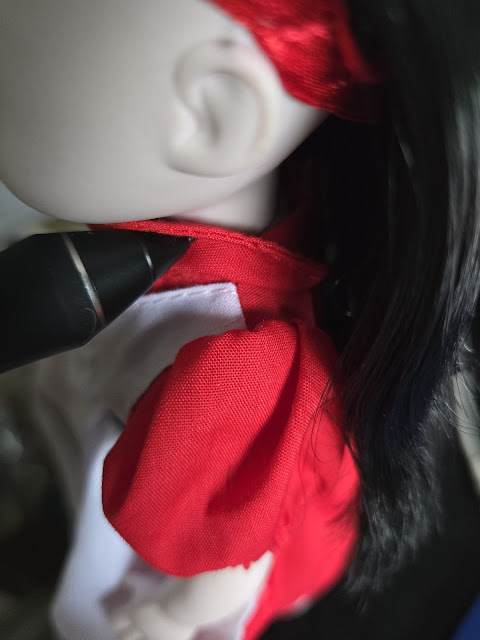

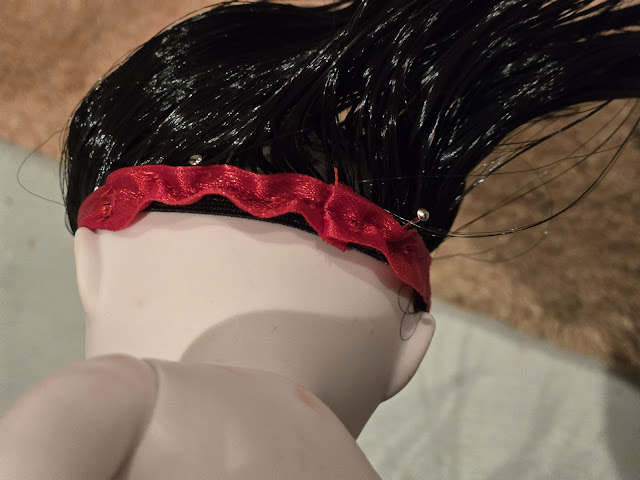








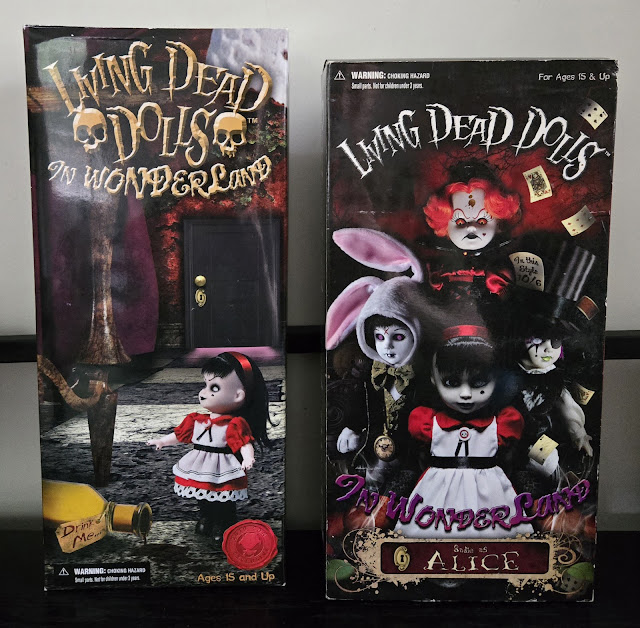
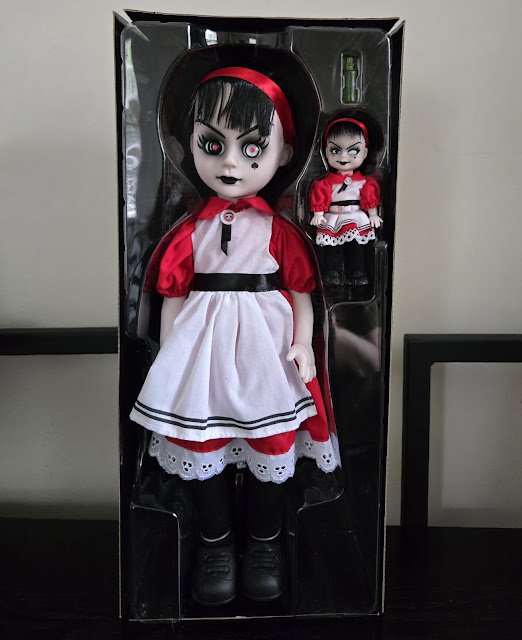

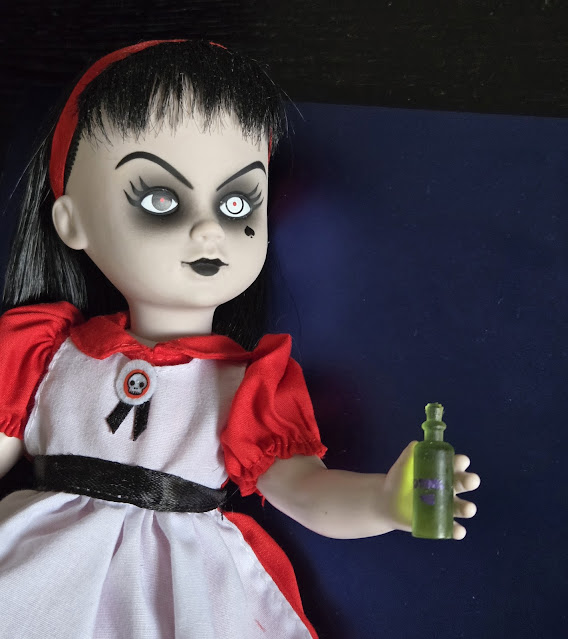



























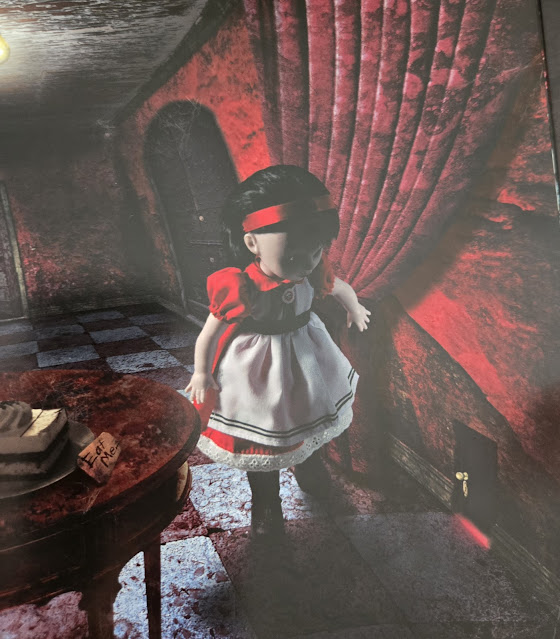


















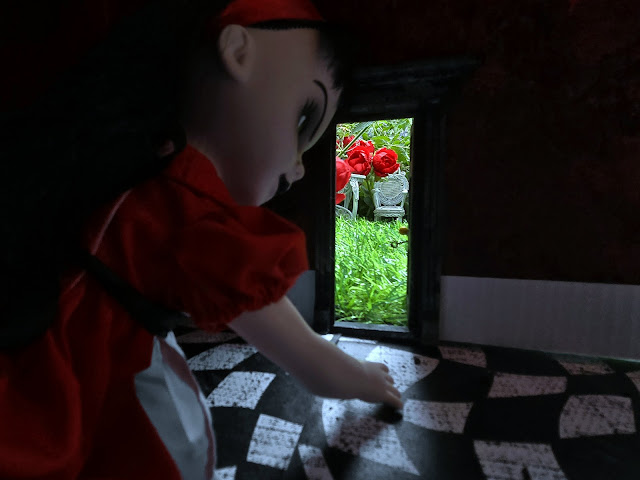































That large Alice is so beautiful, and the mini is hilarious impish compared to her sister selves.
ReplyDeleteGreat job on the staging on this one, beyond the set in general, figuring out all the perspective shots paid off.